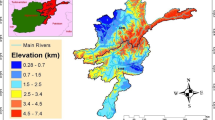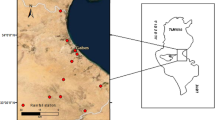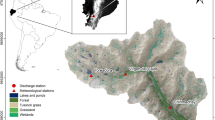Abstract
Normalized Difference Vegetation Index (NDVI) is estimated from Landsat 8 sensor acquired in June 2013 to drive four different water-related indices calculated as NDVI derivatives. Different vegetation indices (VIs) have been extracted exclusively in estimation of different VIs: Leaf Area Index, Water Supply Vegetation Index, Crop Water Shortage Index, and Drought Severity Index in addition to estimation of daily evapotranspiration (ET). Sensitivity analysis assesses the contributions of the inputs to the total uncertainty in the analysis outcomes. Vegetation indices are complex and intercepted, therefore the interceptions of the five different vegetation indices are considered in the current study. A comparative analysis of Gaussian process emulators for performing global sensitivity analysis was used to conduct a variance-based sensitivity analysis to identify which uncertain inputs are driving the output uncertainty. The results showed that the interconnections between different VIs vary, but the extent of the features sensitivity is uncertain. Findings from the current work conducted are anticipated to contribute decisively toward an inclusive VIs assessment of its overall verification. Daily ET is the less sensitive and more certain index followed by Drought Vegetation Index.














Similar content being viewed by others
References
Accorsi, R., Zio, E., & Apostolakis, G. E. (1999). Developing utility functions for environmental decision-making. Progress in Nuclear Energy, 34(4), 387–411.
Afify, A. A., Arafat, S. M., & Aboel Ghar, M. N. (2011). Delineating rice belt cultivation in the Nile pro-Delta of vertisols using remote sensing data of Egypt Sat-1. Journal of Agricultural Research, 35(6), 2263–2279.
Allam, M. N., & Allam, G. I. (2007). Water resources in Egypt: Future challenges and opportunities. Water International, 32(2), 205–218.
Bouman, B. A. M., & Tuong, T. P. (2001). Field water management to save water and increase its productivity in irrigated lowland rice. Agricultural Water Management, 49, 11–30.
Diker, K., & Unlu, M. (1999). Remote sensing for precision agriculture. Journal of Agriculture, 14(1), 7–14.
Dragan, M., Feoli, E., Fernetti, M., & Zerihun, W. (2003). Application of spatial decision support system (SDSS) to reduce soil erosion in northern Ethiopia. Environmental Modeling and Software, 18(10), 861–868.
Edward, P. G., Alfredo, R. H., Pamela, L. N., & Stephen, G. N. (2008). Relationship between remotely-sensed vegetation indices, canopy attributes and plant physiological processes: What vegetation indices can and cannot tell us about the landscape. Sensors, 8, 2136–2160.
Elhag, M. (2010). Land suitability for afforestation and nature conservation practices using remote sensing & GIS techniques. CATRINA, 6(1), 11–17.
Elhag, M. (2014). Remotely sensed vegetation indices and spatial decision support system for better water consumption Regime in Nile Delta. A case study for rice cultivation suitability map. Life Science Journal, 11(1), 201–209.
Elhag, M., Psilovikos, A., Manakos, I., & Perakis, K. (2011). Application of SEBS model in estimating daily evapotranspiration and evaporative fraction from remote sensing data over Nile Delta. Water Resources Management, 25(11), 2731–2742.
Elhag, M., Psilovikos, A., & Sakellariou, M. (2013). Land use changes and its impacts on water resources in Nile Delta region using remote sensing techniques. Environment, Development and Sustainability,. doi:10.1007/s10668-013-9433-5.
FAO. (1976). Framework for land evaluation. Soils Bulletin no 32. Rome.
FAO. (1978). Report on the agroecological zone project. In Methodology and results for Africa, world soil resource report, FAO, 1(48).
FAO. (1983). Guidelines: Land evaluation for rainfed agriculture. Soils Bulletin no. 52 Rome.
FAO. (1984). Guidelines: Land Evaluation for forestry. Soils Bulletin no 48. Rome.
FAO. (1985). Guidelines: Land evaluation for irrigated agriculture. Soils Bulletin no 42. Rome.
FAO. (2005). Environment and natural resources service series, no. 8, Rome, Italy.
Focht, W., DeShong, T., Wood, J., & Whitaker, K. (1999). A protocol for the elicitation of stakeholders’ concerns and preferences for incorporation into policy dialogue. In Proceedings of the third workshop in the environmental policy and economics workshop series: Economic research and policy concerning water use and watershed management, Washington, pp. 1–24.
Gregory, R., & Wellman, K. (2001). Bringing stakeholder values into environmental policy choices: A community-based estuary case study. Ecological Economics, 39, 37–52.
Holvoet, K., van Griensven, A., Seuntjents, P., & Vanrolleghem, P. A. (2005). Sensitivity analysis for hydrology and pesticide supply towards the river in SWAT. Physics and Chemistry of the Earth, 30, 518–526.
Huete, A., Didan, K., van Leeuwen, W., Miura, T., & Glenn, E. (2008). MODIS vegetation indices. In Land remote sensing and global environmental change: NASA’s earth observing system and the science of ASTER and MODIS 2008, pp. 125–146.
Kerr, J., & Ostrovsky, M. (2003). From space to species: Ecological applications for remote sensing. Trends in Ecology & Evolution, 18, 299–305.
Malczewski, J. (1999). GIS and multi-criteria decision analysis (p. 392). New York: Wily.
Myers, N., & Kent, J. (1998). Perverse subsidies: Tax $S undercutting our economics and environments alike. Winnipeg: International Institute for Sustainable Development.
Petropoulos, G., Wooster, M. J., Carlson, T. N., Kennedy, M. C., & Scholze, M. (2009). A global Bayesian sensitivity analysis of the 1d SimSphere soil–vegetation–atmospheric transfer (SVAT) model using Gaussian model emulation. Ecological Modelling, 220(2009), 2427–2440.
Pettorelli, N., Vik, J., Mysterud, A., Gaillard, J., Tucker, C., & Stenseth, N. (2005). Using the satellite-derived NDVI to assess ecological responses to environmental change. Trends in Ecology & Evolution, 20, 503–510.
Postel, S. (1997). Last oasis. Facing water scarcity. New York: W.W. Norton and Company.
Saltelli, A. (2002). Sensitivity analysis for importance assessment. Risk Analysis, 22(3), 549–590.
Saltelli, A., Chan, K., & Scott, E. M. (2000). Sensitivity analysis. In: Wiley series in probability and statistics (pp. 467). Chichester: Wiley. ISBN:0-471-99892-3.
Saltelli, A., Tarantola, S., Campologno, F., & Ratto, M. (2004). Sensitivity analysis in practice: A guide to assessing scientific models (pp. 217). UK: Wiley. ISBN:0-470-87093-1.
Saltelli, A., Tarantola, S., & Chan, K. P. S. (1999). A quantitative model-independent method for global sensitivity analysis of model output. Technometrics, 41(1), 39–56.
Schwieger, V. (2004). Variance-based sensitivity analysis for model evaluation in engineering surveys. In INGEO 2004 and FIG regional central and eastern European conference on engineering surveying Bratislava, Slovakia, November 11–13, 2004.
Sobol, I. M. (2001). Global sensitivity indices for nonlinear mathematical models and their Monte Carlo estimates. Mathematics and Computers in Simulation, 55(1–3):271–280. The Second IMACS Seminar on Monte Carlo Methods (Varna, 1999).
Turban, E., Aronson, J. E., & Liang, T. P. (2005). Decision support systems and intelligent systems. New York: Prentice Hall.
Yager, R. (1988). On ordered weighted averaging aggregation operators in multi-criteria decision making. IEEE Transactions on Systems, Man, and Cybernetics, 18, 183–190.
Author information
Authors and Affiliations
Corresponding author
Rights and permissions
About this article
Cite this article
Elhag, M. Sensitivity analysis assessment of remotely based vegetation indices to improve water resources management. Environ Dev Sustain 16, 1209–1222 (2014). https://doi.org/10.1007/s10668-014-9522-0
Received:
Accepted:
Published:
Issue Date:
DOI: https://doi.org/10.1007/s10668-014-9522-0




